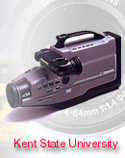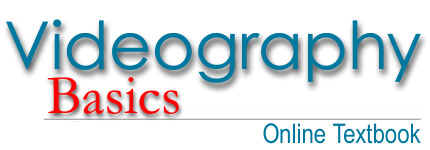

by Jim Stinson
This article originally appeared in
Videomaker Magazine on 01-Jan-99
(C)1998 Videomaker Magazine. Reproduction for uses other than personal is prohibited.
Titles do more than paste labels on your video, they proclaim it a shaped and finished production; a necklace of polished gemstones instead of a handful of rocks. Good titles don't just happen. Let's take a look at how to design them so that they look smart, read easily, and add character to your productions. (For more details on how to actually make and place titles, see Titling For Under a Buck, August 1998 Videomaker).
Present at the Creation
Before turning to aesthetic topics like layout and movement, we have to run a quick review
of title production methods. Why? Because how you make your titles determines what you can
and can't do with them.
You can get great results by shooting real-world titles like signs, posters and print materials. There isn't much else to say about designing them, except to make them legible and keep them inside the screen's "safe title area."
 With high-quality color printers that cost less than $300 you can get snappy
effects by designing your titles in a word processing, publishing or paint program and
then videotaping the printouts. Here's a cool trick: if your switcher can chromakey, make
the title out of big fat letters in the key color so you can composite your video image
inside them. When you videotape the printed titles, zoom in and "through" the
letters. In the composited result, you will fly through your titles into your live action.
With high-quality color printers that cost less than $300 you can get snappy
effects by designing your titles in a word processing, publishing or paint program and
then videotaping the printouts. Here's a cool trick: if your switcher can chromakey, make
the title out of big fat letters in the key color so you can composite your video image
inside them. When you videotape the printed titles, zoom in and "through" the
letters. In the composited result, you will fly through your titles into your live action.
Even with a ho-hum laser printer, you can get great results by printing on colored stock for titles-on-cards. Use paper that's the same color as your key color for chromakeying over live action footage.
With that said, we'll spend the rest of this tour on titles that are built in a computer and output to NTSC video format. There are three main types:
Stand-alone titlers. These black boxes let you create and superimpose high quality titles in a wide range of colors, fonts, and sizes.
- Computer applications like presentation programs, output through an NTSC signal converter. Many current laptops have NTSC output built-in and add-on converters for PCs are widely available from our mail-order pages and elsewhere.
- Nonlinear editing applications which let you do both title creation and superimposition inside of the computer.
Though each method has its special quirks, creating titles is similar with all of them, especially the all-important process of design.
Title Design
Title design is the art of placing text on a video screen. The two principles guiding this
art are readability and style.

Figure 2 illustrates the three aspects of readability: placement, type size and typeface. As you can see from Figure 2a, you need to keep your titles inside a generous perimeter known as the safe title area. Because NTSC screens are set to "overscan," some of the image is outside the display area and you want to make sure your titles don't appear there.
How can you judge the safe title area? Some video editing programs do it for you, but the safest method is to check your work constantly on a TV monitor. Your SVGA computer display shows everything differently, from colors to title placement. (Most designs don't look quite as good on NTSC as on the SVGA, although some colors may come out better).
The computer screen is exceptionally misleading regarding title size because its higher resolution keeps text readable at sizes way too small for TV (Figure 2b). There's no fixed rule, but it is best to keep type at 44 points or larger.
Fancy lettering can also be a problem. Beware of type with skinny serifs, wavy lines, or fiddly bits (Figure 2c). On an average TV screen they fall completely to pieces.

Regarding style, the only rule is to suit the look and feel of the title's type to the character of the program. Figure 3a shows a pair of titles whose type faces have been switched, and Figure 3b shows how they look when the type face is matched to the program style. We could write a book about type (and several people have) but these illustrations basically say it all.
In Living Color
After type, the next most important design element is color. Once again there's no
substitute for experimenting while watching the effect on a TV monitor. Here's a shopping
list of tips for good color:
- Go for clean, well-saturated (intense) colors, avoiding pale shades and earthy/khaki/tannish tones.
- Stay away from warm reds, which tend to smear. Often, magenta on the computer screen will produce a pleasing red on TV.
- Use a simple color scheme, with no more than two colors. Most professional titles use a single color throughout.
When you are planning to superimpose colors over live action, follow these steps for good keying:
- Choose the text color to contrast with the intended live-action background.
- Choose the key color to contrast strongly with the text color. Complementary color combinations are safe (red/cyan, green/magenta, blue/yellow).
- Test the results by feeding the signals through the switcher and fine-tuning the title colors to reduce halos and artifacts.
No matter how hard you try you may not get perfect keying with consumer level gear, so the trick is to keep both elements moving. That is, pick a live action background with lots of motion in it and crawl or roll the titles across the screen. The complex movements will distract they eye from small imperfections in keying.
Incidentally, some older switchers that can't chromakey can lumakey instead. That is, they treat anything darker than a designated brightness (luminance) as the key value. To superimpose lumakeyed titles, create light, bright colored text on a pure black background. The result can be just as successful as chromakeying.
Title Placement
Our examples so far are all centered left and right and aligned slightly above center, up
and down. (Exactly centering titles north and south makes them look heavy).
 Off-center titles can also be effective and they look more distinctive that
plain old centered models. Figure 4 can only suggest the limitless possibilities of
off-center title design. Figure 4a shows the top line justified left and the bottom name
justified right. Figure 4b shows a title superimposed over the action. Figure 4c uses an
alternate approach. Instead of keying the title, the screen is split between a partial
A/B-roll vertical wipe. The split screen approach works very well with "crawls"
(titles that move horizontally across the screen like stock quotes). Crawls are harder to
read over live action than over a solid background.
Off-center titles can also be effective and they look more distinctive that
plain old centered models. Figure 4 can only suggest the limitless possibilities of
off-center title design. Figure 4a shows the top line justified left and the bottom name
justified right. Figure 4b shows a title superimposed over the action. Figure 4c uses an
alternate approach. Instead of keying the title, the screen is split between a partial
A/B-roll vertical wipe. The split screen approach works very well with "crawls"
(titles that move horizontally across the screen like stock quotes). Crawls are harder to
read over live action than over a solid background.
The more common title stream is called a "roll" or "scroll," in which the titles appear at the bottom, move up the screen, and disappear off the top. They almost never roll down instead of up. Rolling down would force the viewer to read from the bottom up. This is an unnatural way to read, it's difficult and makes the view uncomfortable. Though common in professional productions, rolling titles are difficult to achieve.
If you have a slide show program like Corel Presentations or Microsoft PowerPoint, however, you can achieve so many other different kinds of motion you'll never miss the rolling credits. We have room for just one example.
 In Figure 5a, the word "performers" is treated as a main title and
dropped in from above. In Figure 5b and Figure 5c, the cast names are secondary titles
that fly in from the left. In PowerPoint, primary and secondary titles can be assigned
different kinds of movement, but all the secondary lines must move the same. That is, you
couldn't have Ms. Johnson in Figure 5c fly in from the bottom or right.
In Figure 5a, the word "performers" is treated as a main title and
dropped in from above. In Figure 5b and Figure 5c, the cast names are secondary titles
that fly in from the left. In PowerPoint, primary and secondary titles can be assigned
different kinds of movement, but all the secondary lines must move the same. That is, you
couldn't have Ms. Johnson in Figure 5c fly in from the bottom or right.
As for the speed of the movement, your best bet is trial and error. You'll find a pace that's slow enough to read but not enough to bore the audience.
A Word about Content
Although this column is primarily about title design, we need to add just a word about
content as well. That word is share.
We've all suffered stuff like A FILBERT PRODUCTION PRODUCED BY ZANZIBAR FILBERT, DIRECTED BY ZANZIBAR FILBERT, BASED ON AN ORIGINAL IDEA BY ZANZ...
Well, you get it. Though you may well have worn eight hats on your show and done most of the work, don't hog the credits. Unless you're paying at least union scale wages, public credit is all the compensation your cast and crew can expect. So be generous with them.
A good compromise is to start your end credits with something like A ZANZIBAR FILBERT PRODUCTION. Next, credit your helpers generously (meaning with slow-moving credits in prominent type). Then at the end, a single card might say something like:
Written, directed, and edited
by
ZANZIBAR FILBERT
Looks classy that way, doesn't it?
This article
originally appeared in
Videomaker Magazine January 1999.
Reprinted with permission from
Videomaker Magazine, Chico CA. Videomaker, Inc. All Rights Reserved.
Home Page | Assignments | Syllabus | Instructor | JMC Web Site